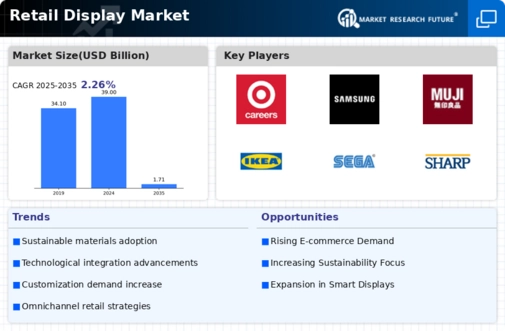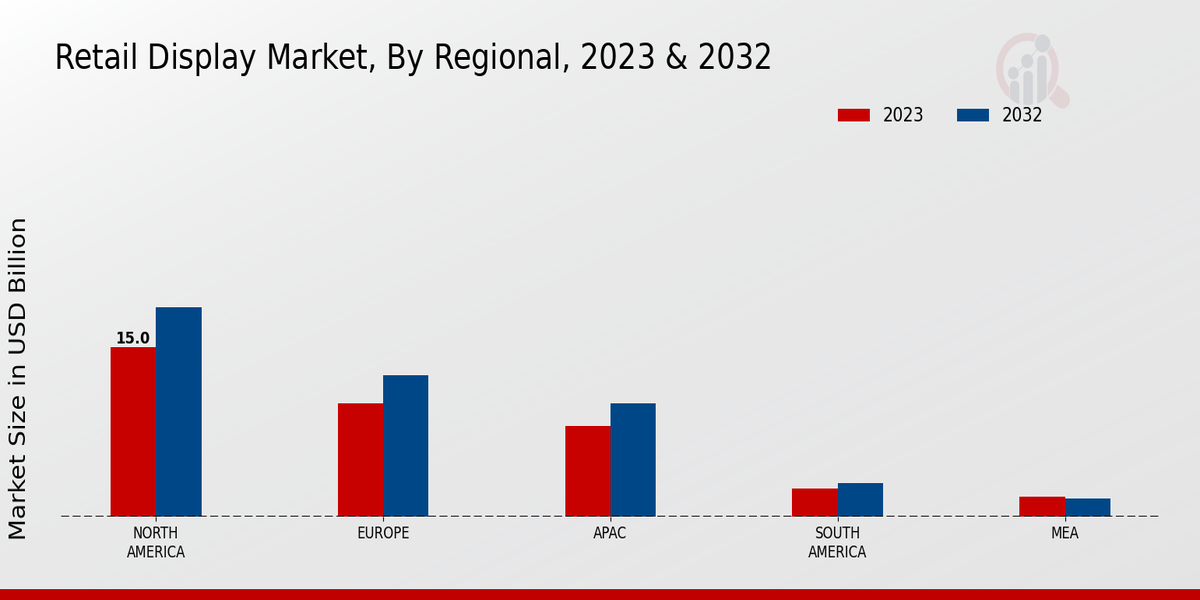E-commerce Growth
The rise of e-commerce has significantly influenced the Global Retail Display Market Industry, compelling brick-and-mortar stores to rethink their display strategies. As online shopping continues to grow, physical retailers are focusing on creating immersive in-store experiences that cannot be replicated online. This shift is evident in the increasing investment in visually appealing displays that highlight products effectively. Retailers are likely to allocate more resources to enhance their physical presence, potentially leading to a market valuation of 39.0 USD Billion in 2024, as they strive to capture the attention of consumers who are accustomed to the convenience of online shopping.
Regulatory Compliance
Regulatory compliance is an essential factor influencing the Global Retail Display Market Industry, as governments worldwide implement stricter guidelines regarding advertising and product displays. Retailers must navigate these regulations to avoid penalties and maintain brand integrity. Compliance often necessitates investment in updated display technologies and materials that meet safety and environmental standards. This focus on adherence to regulations can drive costs but also encourages innovation in display solutions. As the market adapts to these regulatory changes, it is likely to see a decline, with a projected CAGR of -24.74% for 2025-2035, emphasizing the importance of compliance in shaping market dynamics.
Sustainability Trends
Sustainability is becoming a crucial driver in the Global Retail Display Market Industry, as consumers increasingly prefer eco-friendly products and practices. Retailers are responding by adopting sustainable materials for displays and implementing energy-efficient technologies. For example, displays made from recycled materials are gaining traction, appealing to environmentally conscious shoppers. This trend not only aligns with consumer preferences but also helps retailers reduce their carbon footprint. As sustainability becomes a focal point, the market is projected to evolve, with a potential valuation of 39.0 USD Billion in 2024, reflecting the growing importance of eco-friendly practices in retail.
Consumer Behavior Shifts
Changing consumer behaviors are reshaping the Global Retail Display Market Industry, as shoppers seek personalized and engaging experiences. Retailers are increasingly focusing on understanding customer preferences and tailoring displays accordingly. This shift is evident in the rise of experiential retail, where displays are designed to create memorable interactions. For instance, brands that incorporate storytelling into their displays often see higher customer retention rates. As these trends continue to evolve, the market may experience fluctuations, with projections indicating a decline to 1.71 USD Billion by 2035, reflecting the need for retailers to adapt to shifting consumer expectations.
Technological Advancements
The Global Retail Display Market Industry is experiencing a surge in technological advancements that enhance customer engagement and streamline operations. Innovations such as digital signage and interactive displays are becoming increasingly prevalent, allowing retailers to create dynamic shopping experiences. For instance, retailers utilizing augmented reality in displays report a notable increase in customer interaction and sales. This trend is expected to contribute to the market's valuation of 39.0 USD Billion in 2024, as businesses invest in cutting-edge technologies to attract consumers and differentiate themselves in a competitive landscape.
Market Trends and Projections
The Global Retail Display Market Industry is characterized by various trends and projections that reflect its evolving nature. Current estimates indicate a market valuation of 39.0 USD Billion in 2024, with expectations of a decline to 1.71 USD Billion by 2035. This trajectory suggests a significant contraction, with a CAGR of -24.74% anticipated for the period from 2025 to 2035. Such projections highlight the need for retailers to adapt their strategies in response to changing market conditions and consumer preferences, ensuring they remain competitive in a rapidly evolving landscape.














